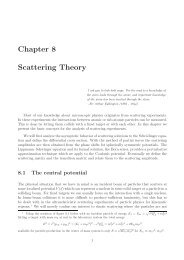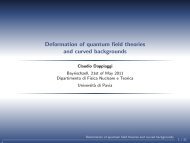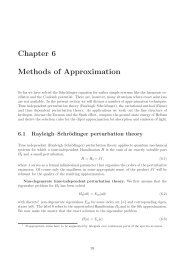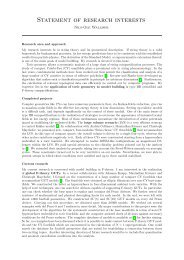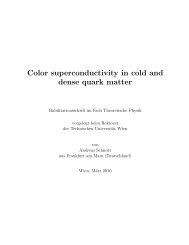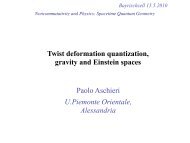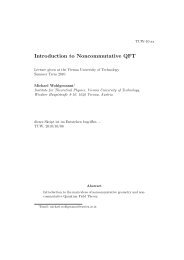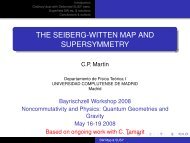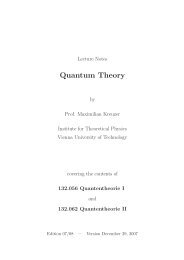Chapter 8 Scattering Theory - Particle Physics Group
Chapter 8 Scattering Theory - Particle Physics Group
Chapter 8 Scattering Theory - Particle Physics Group
You also want an ePaper? Increase the reach of your titles
YUMPU automatically turns print PDFs into web optimized ePapers that Google loves.
CHAPTER 8. SCATTERING THEORY 150<br />
Since (8.99) is a linear differential equation with constant coefficients we can determine the<br />
Green’s function by Fourier transformation. Because of translation invariance<br />
G 0 (k,⃗x,⃗x ′ ) = G 0 (k, ⃗ R) with ⃗ R = ⃗x − ⃗x ′ , (8.103)<br />
hence<br />
G 0 (k,⃗x − ⃗x ′ ) =<br />
δ(⃗x − ⃗x ′ ) =<br />
∫<br />
1<br />
(2π) 3 ∫<br />
1<br />
(2π) 3<br />
e i ⃗ K·⃗R ˜g 0 (k, ⃗ K)d ⃗ K (8.104)<br />
e i ⃗ K·⃗R d ⃗ K. (8.105)<br />
Substituting the Fourier representations into the defining equation of the Green’s function<br />
(8.99) we find that<br />
˜g 0 (k, K) ⃗ 1<br />
=<br />
k 2 − K2. (8.106)<br />
Since ˜g 0 has a pole on the real axis we give a small imaginary part to k and define<br />
G ± 0 (k,⃗x,⃗x ′ ) = 1<br />
(2π) 3 ∫<br />
e i ⃗ K·(⃗x−⃗x ′ )<br />
k 2 − K 2 ± iε d ⃗ K. (8.107)<br />
Let (K, Θ, Φ) be the spherical coordinates of ⃗ K and let the z-axis be along ⃗ R = ⃗x − ⃗x ′ . Then<br />
G ± 0 (k, R) ⃗ = 1 ∫ ∞ ∫ π<br />
dKK 2<br />
(2π) 3<br />
0<br />
0<br />
∫ 2π<br />
dΘ sin Θ<br />
0<br />
cos Θ<br />
eiKR<br />
dΦ<br />
k 2 − K 2 ± iε . (8.108)<br />
Performing the angular integrations and observing that the integrand is an even function of K<br />
we can extend the integral from −∞ to +∞ and obtain<br />
G ± 0 (k, ⃗ R) = 1<br />
8π 2 iR<br />
∫ +∞<br />
−∞<br />
K(e iKR − e −iKR ))<br />
dK. (8.109)<br />
k 2 − K 2 ± iε<br />
(<br />
1<br />
With the partial fraction decomposition = − 1 1<br />
+ 1<br />
k 2 −K 2 2K K−k K+k)<br />
we can split the integral<br />
into two parts<br />
i<br />
G 0 (k,R) =<br />
16π 2 R (I 1 − I 2 ), (8.110)<br />
with<br />
I 1 =<br />
I 2 =<br />
∫ +∞<br />
−∞<br />
∫ +∞<br />
−∞<br />
( 1<br />
e iKR K − k + 1 )<br />
K + k<br />
e −iKR ( 1<br />
K − k + 1<br />
K + k<br />
dK (8.111)<br />
)<br />
dK (8.112)<br />
The integrals can now be evaluated using the Cauchy integral formula if we close the integration<br />
path with a half-circle in the upper or lower complex half-plane, respectively, so that the<br />
contribution from the arcs at infinity vanish. The ambiguity of the Green’s function arises<br />
from different choices of the integration about the poles of the integrand on the real axis, and<br />
different pole prescriptions obviously differ by terms localized at K 2 = k 2 and hence by a




